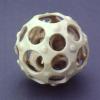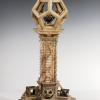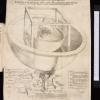Dresden, 1581: Georg Wecker's polyhedra
Commentary
PRESCRIBED SOURCE
Perforated polyhedron, 1581, by Georg Wecker. Material: ivory, wood. Dimensions: height 116 mm, diameter (base) 54 mm. Source: Staatliche Kunstsammlung Dresden: from the ducal Kunstkammer (the Grünes Gewölbe), Inventory Number II 290.
In 1578, Georg Wecker (1566-1636) was called to Dresden in order to instruct Elector August and his son, the young Duke Christian, in the newly-invented art of ivory turning. Wecker did not arrive until 1581, and the three sets of polyhedra in the electoral collection dated from that year were presumably presented as pieces demonstrating the heights of his abilities. This example consists of four concentric perforated dodecahedrons of decreasing size. The largest is fixed to a turned ivory stand; the others are placed one inside another, like the skins of an onion, so that each can be moved independently. Their productionrequired both theoretical mastery of geometry and perspective and the utmost artisanal skill, above all when working on this tiny scale: the largest of these polyhedral is scarcely two inches in diameter.
This tiny object is also representative of several aspects of the 'art' and 'science' practiced in leading German courts around 1600. One is the fascination with polyhedra, stimulated in Germany by the publication of Perspectiva corporum regularium(1569) by the leading Nuremberg goldsmith, Wenzel Jamnitzer. Not only was a copy of this book owned by the Elector: drawings based on it survive executed in 1576-7 by Duke Christian himself, while only sixteen years of age. More specific is the fascination with nested polyhedra, perhaps deriving from Ptolemaic cosmology, reflected in the armillary spheres and celestial clocks of the period, and shortly to culminate in Kepler’s Mysterium cosmographicum. No less striking is the determination of leading German princes of this period to master the most sophisticated of manual arts – in deliberate contravention of the ancient prejudice against aristoctrats engaging in the ‘mechanical arts’. Wecker had previously taught the art of turning ivory to Duke Albrecht V of Bavaria, who was most reluctant to release him from service in Munich. In Saxony he found a devoted princely apprentice: on his death in 1586, Duke August left 165 turned works in ivory, many of which were prominently displayed by his son for the rest of the century.
In addition to further work by Georg Wecker, fine examples of the ivory-turners art were produced in Dresden by Egidius Lobenigk, Georg Friedel, and Jacob Zeller.
Credit: Howard Hotson (February 2017), drawing on Dirk Syndram and Antje Scherner, Princely Splendor: the Dresden Court, 1580-1620 (Milan, Dresden and New York, 2004), pp. 176-97.



